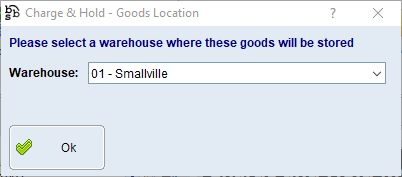The Charge and Hold system allows users to invoice customers for goods that they do not necessarily have in stock, with a view to supplying those goods at a later date. BBS will track the quantity of each product invoiced as Charge and Hold for each customer, and will ensure the customer can only receive the quantity they have already been invoiced for at no charge.
Reasons for using this module are:
1.You agree on a special price for a product with a customer, but the caveat is that they must pay up-front for a bulk lot of the product.
2.A customer requests an invoice prior to the goods being available for despatch (eg at EOFY)
3.A customer requests to purchase a large quantity of a product up-front for budgeting purposes, but wants to receive the stock later, in multiple deliveries, as required.
The Charge and Hold system has two different transaction types:
•The Billing Order which invoices the customer for the product(s) without affecting inventory; and
•The Releasing Orders which allows the release of the goods, previously purchased via a C&H billing invoice, for no charge.
Both will be explained below.
Charge and Hold Billing sales orders - You invoice the customer for a bulk lot of goods using the warehouse code CH at the agreed price. This will not affect stock and will record against the customer the quantity of product that is owed to them. G/P is calculated as sell price vs future cost on the item. To facilitate this:
1.Enter a sales order for the customer and click the drop down arrow in the Sales Order Options section and select the C&H Billing Order. This will change the warehouse code to CH automatically.
2.Select the warehouse where the goods will be stored and released from.

3.Enter the product code, quantity and agreed price. Add the line. Enter multiple products if you wish. Please note that you don’t actually have to have the quantity of the product on hand to do this (ie. you can charge and hold goods you don’t have).
4.You can then Save Order & Auto Invoice, select Charge and Hold as the Ship Via option, zero parcels, and then say Yes to run the invoice update.
or
Save the Order, print the charge and hold billing sales order out and then once ready to invoice it, use Manually Invoice Sales Orders to invoice it.
NOTE: No picking slip is generated, and the order does not go on a picking run, as there is no action for the warehouse to take at this point.
Charge and Hold Release sales orders - At any time the customer requires these goods to be released at no charge, a charge and hold release sales order is entered, in the warehouse where the goods are to be despatched from (eg. 01), which draws down the stock. G/P is $0.00/0% and any variance between the original cost and the stock cost (average) is taken up in the General Ledger as Material Price Variance. You facilitate a release by:
1.Entering a sales order and click the drop down arrow in the Sales Order Options section and select the C&H Release option.
2.Enter the product and the quantity to be released. BBS will not allow the entry of a price as the customer has already paid for the goods. If you try to release a quantity greater than is available to the customer you will be warned as follows. BBS looks at what has been previously released and also anything that is already on a sales order pending release when calculating how much can be released at no charge. NOTE: Charge and hold releases can go on backorder like any other order if not enough stock is available.

3.Enter freight if required and Save Order OR Save Order & Auto-Invoice as required.
4.If Save Order is used, the order will go on a picking run and be invoiced at $0.00, it will deduct the stock and will deduct the quantity released from the liability owed to the customer. Backorders and products below minimum stock levels will come up for ordering – just like any other sales order.
Charge and Hold Status – You can review the status of a charge and hold arrangement any time by:
1.Using the C&H Stock tab in the Sales & Service section of the Global Customer Enquiry. It will show you the liability and also all of the transactions (billings and releases) for a particular product if you double click it.
2.By running the Charge & Hold liability report on the inventory control reports menu.
Financials & Adjustments – Below describes the financial transactions that occur behind the charge and hold transactions.
1.When billing the customer for C&H goods, the future cost is used to calculate the cost of goods sold. As no stock is actually moving, the credit for this transaction is journaled to the liability account CHARGE AND HOLD LIABILITY.
2.When the goods are released, the stock is credited from your stock on hand account, and the quantity X original cost is debited from the 2820 account reducing the liability. Any difference between the original cost used on the billing transaction and the cost of the stock being released is taken up as MATERIAL PRICE VARIANCE.
3.Super-users can adjust the quantity that you owe a customer of an item in the charge and hold ledger buy highlighting the item and using the Adjustment button in the C&H stock screen in Global Customer Enquiry.
4.At the EOFY, the CHARGE AND HOLD LIABILITY account should reconcile to the Charge & Hold Liability report on the Inventory Control reports menu, apart from any manual adjustments that have been made to the C&H ledgers during the financial year. A general journal might be required June 30 to account for any C&H adjustments.